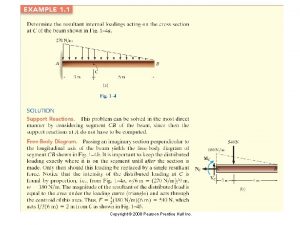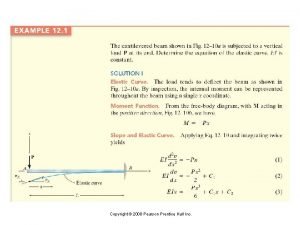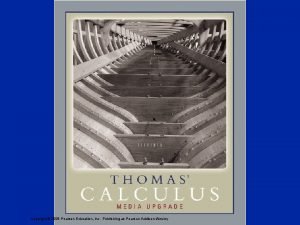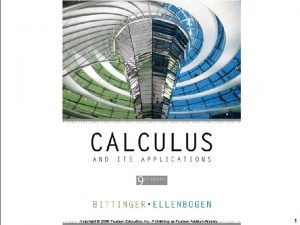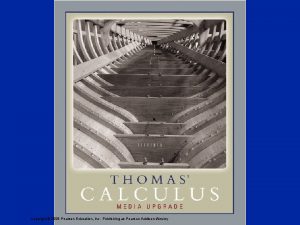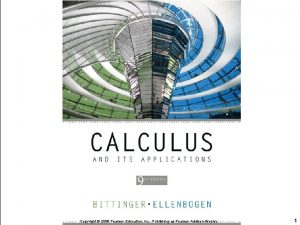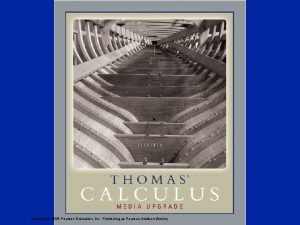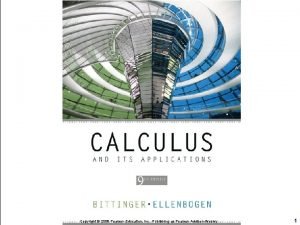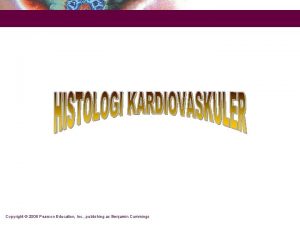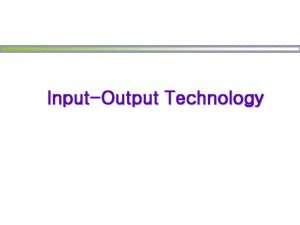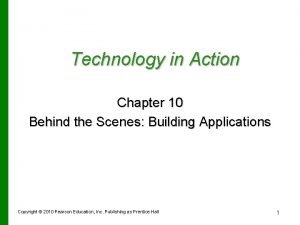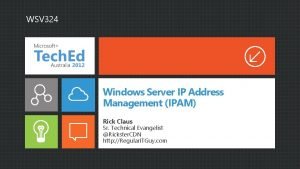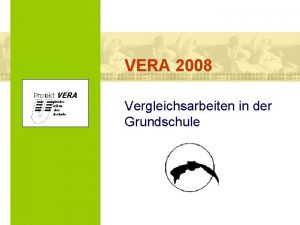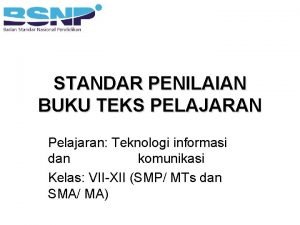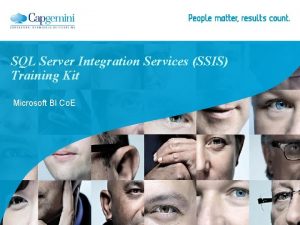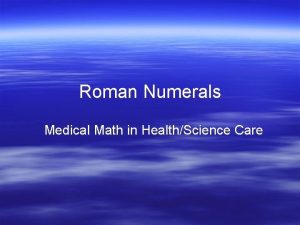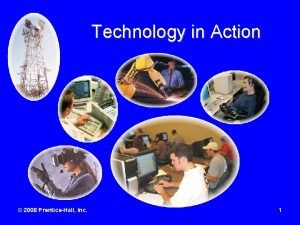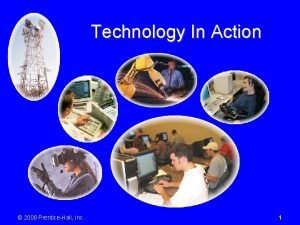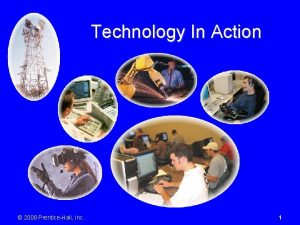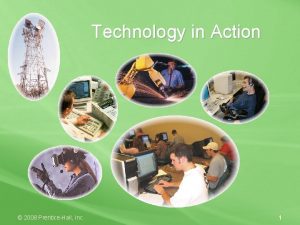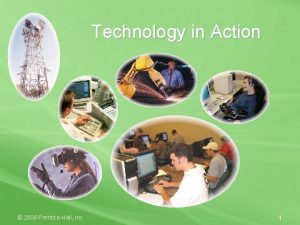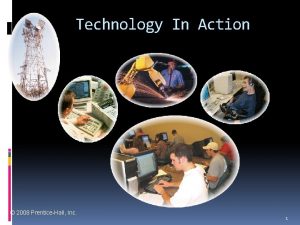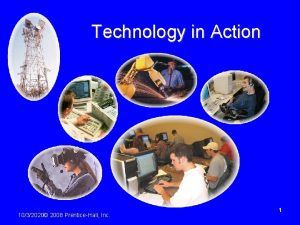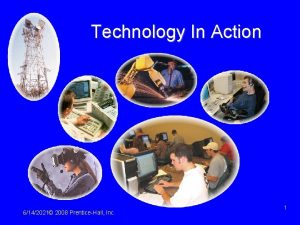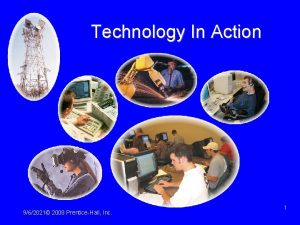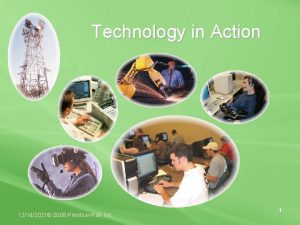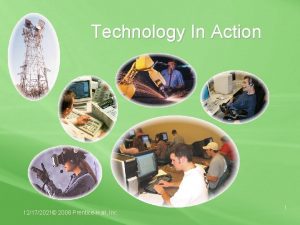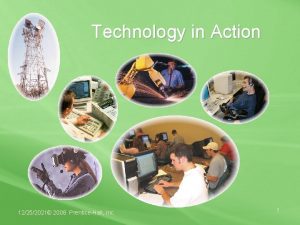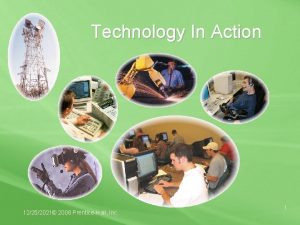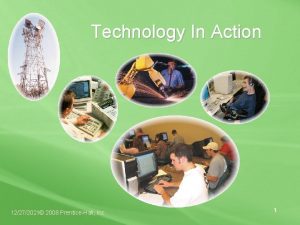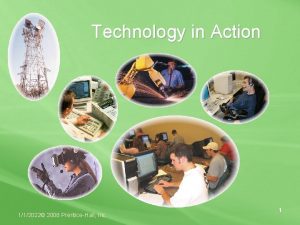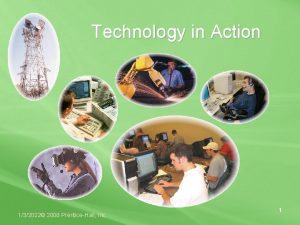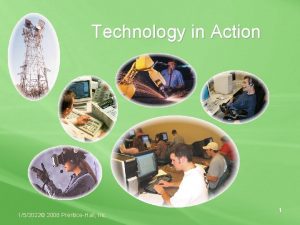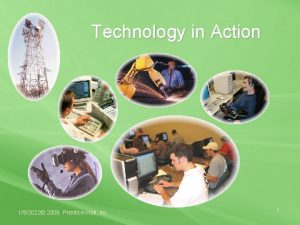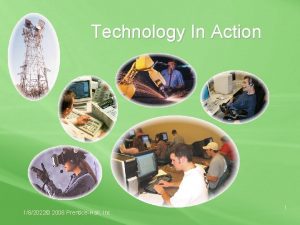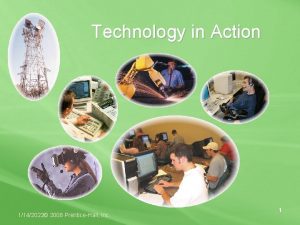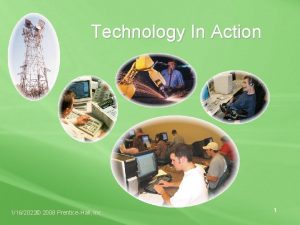Technology in Action 6132021 2008 PrenticeHall Inc 1



































- Slides: 35

Technology in Action 6/13/2021© 2008 Prentice-Hall, Inc. 1

Technology in Action Chapter 9 Behind the Scenes: A Closer Look at System Hardware 6/13/2021© 2008 Prentice-Hall, Inc. 2

Chapter Topics • • Computer switches Binary number system Inside the CPU Cache memory Types of RAM Computer buses Creating faster CPUs 6/13/2021© 2008 Prentice-Hall, Inc. 3

Binary Language • Computers work in binary language • Consists of two numbers: 0 and 1 • Everything a computer does is broken down into a series of 0 s and 1 s • Switches: Devices inside the computer that can be flipped between these two states: 1 or 0, on or off 6/13/2021© 2008 Prentice-Hall, Inc. 4

Switches • Nonmechanical devices in computers that open and close circuits • Types of electrical switches: Vacuum Tube – Vacuum tubes – Transistors: • Semiconductors – Integrated circuits Transistors 6/13/2021© 2008 Prentice-Hall, Inc. Integrated Circuits 5

Switches Representing Data • The on/off state of a switch represents one bit of data OFF ON • Bit (binary digit) – On = 1 – Off = 0 0 1 OR 1 6/13/2021© 2008 Prentice-Hall, Inc. = 1 bit 0 6

The Binary Number System • Describes a number as powers of 2 • Also referred to as base 2 numbering system • Used to represent every piece of data stored in a computer: all of the numbers, letters, and instructions 6/13/2021© 2008 Prentice-Hall, Inc. 7

The Binary Number System • Number systems are organized ways to represent numbers • Each number in one system has a corresponding number in another. Binary Base 10 128 2 x 64 64 2 x 32 32 2 x 16 16 2 x 8 8 2 x 4 4 2 x 2 2 2 x 1 1 0 0 1 0+ 16 + 8+ 0+ 0+ 0 + 64 + 1 = 89 01011001 = 89 Binary Base 10 6/13/2021© 2008 Prentice-Hall, Inc. 8

Representing Letters and Symbols • American Standard Code • Unicode for Information – 16 bits equal 1 byte Interchange (ASCII) – 65, 000 different – 8 bits = 1 byte = alphanumeric character or symbol – 256 different combinations, used for all languages 01100001 = a ASCII 01000001 = A 00100011 = # 01101101 = m 6/13/2021© 2008 Prentice-Hall, Inc. 9

The CPU: Processing Digital Information • The CPU is the brains of the computer • Different types of CPUs – Intel and AMD chips: Used in most Windows-based PCs – Apple systems use different CPU design • Differentiating CPUs – Processing power – Clock speed and cache 6/13/2021© 2008 Prentice-Hall, Inc. 11

Processors on the Market Today Processor Manufacturer Number of Transistors Typical Clock Speed Levels of Cache Storage Description Athlon 64 FX – 60 AMD 233 million 2. 6 GHz 2 64 -bit processor for heavy computation and demanding video gaming needs. Core Duo Intel 151. 6 million 1. 6 - 2. 16 GHz 2 Designed specifically for mobile computers; transfers power only to those areas of the processor that need it, improving battery life. Itanium 2 Intel 410 million 1. 3 – 1. 66 GHz 3 Seen in high-end server computers. Pentium 4 Extreme Edition 955 Intel 225 million 3. 46 GHz Each processor core has its own 2 MB L 2 Cache This processor uses a dual–core design and hyperthreading to Process four tasks at once. Pentium D Dual Core Intel 230 million 2. 8 - 3. 4 GHz 2 New dual-core processor for more efficient multitasking. No hyperthreading capabilities. Power. PC G 4 Freescale Semiconductor (once part of Motorola) 57 million 1. 5 – 1. 67 GHz 3 Until 2006, powered the Apple line of computers. Dual Core Power. PC G 5 IBM 58 million 2. 0 - 2. 5 GHz 2 Powerful 64 -bit processor for heavy computational needs. Sempron AMD 68. 5 million 2. 0 GHz 2 Affordable performance for today’s value-conscious buyers of desktop PCs. Turion AMD 114 million 1. 6 – 2. 4 GHz 2 Optimized for better performance in thinner and lighter laptops for longer battery life and compatible with wireless technologies. 6/13/2021© 2008 Prentice-Hall, Inc. 12

The CPU Machine Cycle • Fetch – The program’s binary code is “fetched” from its temporary location in RAM and moved to the CPU • Decode – The program’s binary code is decoded into commands that the CPU understands. • Execute – The ALU performs the calculations. • Store “Inside the Chip” by Intel Video Clip – The results are stored in the registers 6/13/2021© 2008 Prentice-Hall, Inc. 13

The System Clock • • • Located on the motherboard Controls the CPU’s processing cycles Clock cycle – Pulse or tick • Clock speed – Number of pulses per second – Measured in hertz (Hz) 6/13/2021© 2008 Prentice-Hall, Inc. 14

The Control Unit • Manages the switches inside the CPU • Is programmed by CPU designers to remember the sequence of processing stages for that CPU • Moves each switch to its correct setting (on or off) • Then performs the work of that stage 6/13/2021© 2008 Prentice-Hall, Inc. 15

The Arithmetic Logic Unit (ALU) • Part of the CPU designed to perform mathematical operations (addition, subtraction, multiplication, division, etc. ) • Also performs logical OR, AND, and NOT operations • Is fed data from the CPU registers – Word size: Number of bits a computer can work with at a time 6/13/2021© 2008 Prentice-Hall, Inc. 16

Cache Memory • Small amount of memory located on the CPU chip or near it • Stores recent or frequently used instructions and data • Used for quick access by the CPU • Different levels of cache 6/13/2021© 2008 Prentice-Hall, Inc. 17

RAM: The Next Level of Temporary Storage • Volatile: When you turn off your computer, the data is erased • Several kinds of RAM exist • Each type of RAM has a different design – Some types work at much faster speeds – Some transfer data more quickly 6/13/2021© 2008 Prentice-Hall, Inc. 18

Types of RAM: DRAM • Dynamic RAM (DRAM) – – Cheapest and most basic type of RAM Loses its electrical charge Needs to be refreshed Many types of DRAM • SDRAM: Synchronous DRAM • DDR SDRAM: Double data rate SDRAM 6/13/2021© 2008 Prentice-Hall, Inc. 19

Types of RAM: SRAM • Static RAM (SRAM) – Does not lose its electrical charge – Faster than DRAM – More expensive than DRAM – Used only in locations like cache memory 6/13/2021© 2008 Prentice-Hall, Inc. 20

Buses: The CPU’s Data Highway • Bus – Electrical pathway used to move data between components – Local bus: Connects the CPU with the memory – Expansion bus: Connects the CPU with peripheral devices 01100010 01001000 01110011 00100111 6/13/2021© 2008 Prentice-Hall, Inc. 21

Bus Performance • Bus clock speed – Rate of speed data moves from one location to another – Measured in MHz (millions of clock cycles per second) • Bus width – The number of bits of data moved on a bus at any one time – Measured in bits • 16 bits • 32 bits 6/13/2021© 2008 Prentice-Hall, Inc. 22

Types of Expansion Buses • ISA and EISA – Found on older computers – Connects mouse, modem, and sound card • PCI – Faster than ISA and EISA – Found on modern computers – Connects network, modem, and sound cards • AGP – Used for three-dimensional graphics – Connects the graphics card and memory 6/13/2021© 2008 Prentice-Hall, Inc. 23

Moore’s Law • Number of transistors on a CPU will double every 18 months • First chip had 29, 000 transistors • Pentium chip 169, 000 transistors • Moore’s Law has been accurate for more than 40 years • Law has remained accurate into the 21 st century 6/13/2021© 2008 Prentice-Hall, Inc. 24

Making Computers Faster • Pipelining: The CPU processes more than one instruction at a time Nonpipelined CPU Instruction 1 Fetch Decode Execute Store Instruction 2 Fetch Decode Execute Store Pipelined CPU Instruction 1 Fetch Instruction 2 Decode Fetch Execute Decode Store Execute Store Fetch Decode Execute Store Instruction 4 Fetch Decode Execute Instruction 3 6/13/2021© 2008 Prentice-Hall, Inc. Store 25

Making Computers Faster • Dual processing – Two CPUs on the same system – Each processor shares the workload Dual processors • Parallel processing – Network of computers – Each computer works on a portion of the problem simultaneously 6/13/2021© 2008 Prentice-Hall, Inc. 26

Dual-core Processing and Hyperthreading • • • Two separate parallel processing paths Almost as fast as two separate processors Hyperthreading allows the processor to run four tasks at once • Allows multiple applications to execute much more quickly 6/13/2021© 2008 Prentice-Hall, Inc. 27

Computing Clusters • • • Group of computers Connected by “clustering software” Load-balancing principle Not as fast as supercomputers Can be set up on Linux systems for free 6/13/2021© 2008 Prentice-Hall, Inc. 28

Chapter 9 Summary Questions • What is a switch and how does it work in a computer? 6/13/2021© 2008 Prentice-Hall, Inc. 29

Chapter 9 Summary Questions • What is the binary number system and what role does it play in computer system? 6/13/2021© 2008 Prentice-Hall, Inc. 30

Chapter 9 Summary Questions • What is inside the CPU and how do these components operate? 6/13/2021© 2008 Prentice-Hall, Inc. 31

Chapter 9 Summary Questions • How does a CPU process data and instructions? 6/13/2021© 2008 Prentice-Hall, Inc. 32

Chapter 9 Summary Questions • What is cache memory? 6/13/2021© 2008 Prentice-Hall, Inc. 33

Chapter 9 Summary Questions • What types of RAM are there? 6/13/2021© 2008 Prentice-Hall, Inc. 34

Chapter 9 Summary Questions • What is a bus and how does it function in a computer system? 6/13/2021© 2008 Prentice-Hall, Inc. 35

Chapter 9 Summary Questions • How do manufacturers make CPUs so that they run faster? 6/13/2021© 2008 Prentice-Hall, Inc. 36
 2008 2008
2008 2008 Pearson education inc publishing as pearson prentice hall
Pearson education inc publishing as pearson prentice hall 2008 pearson prentice hall inc
2008 pearson prentice hall inc 2008 pearson prentice hall inc
2008 pearson prentice hall inc 2008 pearson education inc
2008 pearson education inc 2008 pearson education inc
2008 pearson education inc 2008 pearson education inc
2008 pearson education inc 2008 pearson education inc
2008 pearson education inc 2008 pearson education inc
2008 pearson education inc Pearson
Pearson 2008 pearson education inc
2008 pearson education inc 2008 pearson education inc
2008 pearson education inc Petro-tech heat technology inc
Petro-tech heat technology inc Photon assay technology
Photon assay technology Posiflex india
Posiflex india Alat input dan fungsinya
Alat input dan fungsinya Ron hranac
Ron hranac Medias.res
Medias.res Third person point of view example
Third person point of view example 5 stages of plot development
5 stages of plot development The black cat exposition
The black cat exposition Suit the action to the word the word to the action meaning
Suit the action to the word the word to the action meaning Technology in action
Technology in action Technology in action
Technology in action Technology in action
Technology in action Windows server 2008 ip address management
Windows server 2008 ip address management 2008-2009 school year
2008-2009 school year After warhol double mona lisa peanut butter and jelly
After warhol double mona lisa peanut butter and jelly Projekt vera 3
Projekt vera 3 Microsoft server
Microsoft server 2008 generation called
2008 generation called Penyajian hasil penilaian sebuah buku dalam bentuk
Penyajian hasil penilaian sebuah buku dalam bentuk Ssis 2008 training
Ssis 2008 training 2008 in roman numerals
2008 in roman numerals Kko:2008:57
Kko:2008:57 Is algae plural or singular
Is algae plural or singular


